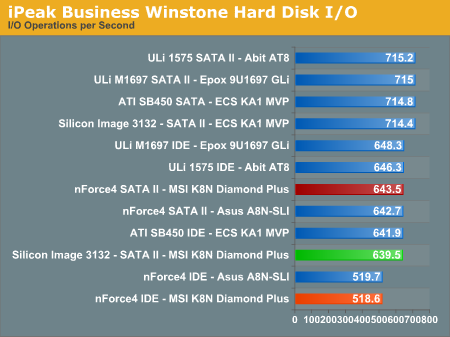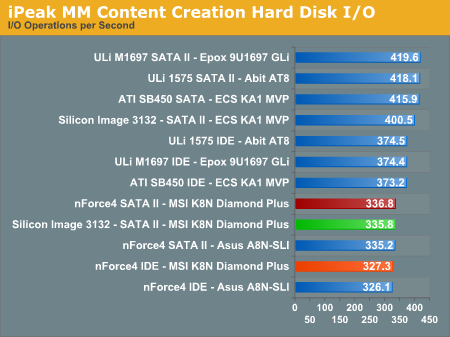Disk Controller Performance
With the variety of disk drive benchmarks available, we needed a means of comparing the true performance of the wide selection of controllers. The logical choice was Anand's storage benchmark first described in Q2 2004 Desktop Hard Drive Comparison: WD Raptor vs. the World. The iPeak test was designed to measure "pure" hard disk performance, and in this case, we kept the hard drive as consistent as possible while varying the hard drive controller. The idea is to measure the performance of a hard drive controller with a consistent hard drive.
We played back Anand's raw files that recorded I/O operations when running a real world benchmark - the entire Winstone 2004 suite. Intel's iPEAK utility was then used to play back the trace file of all IO operations that took place during a single run of Business Winstone 2004 and MCC Winstone 2004. To try to isolate performance differences to the controllers that we were testing, we used the Maxtor MaXLine III 7L300S0 300GB 7200 RPM SATA drive in all tests. The drive was formatted before each test run and a composite average of 5 tests on each controller interface was tabulated in order to ensure consistency in the benchmark.
iPeak gives a mean service time in milliseconds; in other words, the average time that each drive took to fulfill each IO operation. In order to make the data more understandable, we report the scores as an average number of IO operations per second so that higher scores translate into better performance. This number is meaningless as far as hard disk performance is concerned in our tests, as it is just the number of IO operations completed in a second. However, the scores are useful for comparing "pure" performance of the storage controllers in this case.


The performance patterns hold steady across both Multimedia Content IO and Business IO, with the ULi and ATI based disk controllers providing the fastest IO operations followed by the on-board NVIDIA nForce4 SATA controllers. The Silicon Image 3132 controller is able to provide performance almost equal to that of the NVIDIA nForce4 chipset.
With the variety of disk drive benchmarks available, we needed a means of comparing the true performance of the wide selection of controllers. The logical choice was Anand's storage benchmark first described in Q2 2004 Desktop Hard Drive Comparison: WD Raptor vs. the World. The iPeak test was designed to measure "pure" hard disk performance, and in this case, we kept the hard drive as consistent as possible while varying the hard drive controller. The idea is to measure the performance of a hard drive controller with a consistent hard drive.
We played back Anand's raw files that recorded I/O operations when running a real world benchmark - the entire Winstone 2004 suite. Intel's iPEAK utility was then used to play back the trace file of all IO operations that took place during a single run of Business Winstone 2004 and MCC Winstone 2004. To try to isolate performance differences to the controllers that we were testing, we used the Maxtor MaXLine III 7L300S0 300GB 7200 RPM SATA drive in all tests. The drive was formatted before each test run and a composite average of 5 tests on each controller interface was tabulated in order to ensure consistency in the benchmark.
iPeak gives a mean service time in milliseconds; in other words, the average time that each drive took to fulfill each IO operation. In order to make the data more understandable, we report the scores as an average number of IO operations per second so that higher scores translate into better performance. This number is meaningless as far as hard disk performance is concerned in our tests, as it is just the number of IO operations completed in a second. However, the scores are useful for comparing "pure" performance of the storage controllers in this case.


The performance patterns hold steady across both Multimedia Content IO and Business IO, with the ULi and ATI based disk controllers providing the fastest IO operations followed by the on-board NVIDIA nForce4 SATA controllers. The Silicon Image 3132 controller is able to provide performance almost equal to that of the NVIDIA nForce4 chipset.










42 Comments
View All Comments
OvErHeAtInG - Tuesday, April 18, 2006 - link
Let me be the devil's advocate here. I know AT reviews (and others) usually regard same-colored RAM slots to be "correct" for dual-channel operation, but for me it's always made more sense when it's like this MSI board--one color for each channel. Of course, it wouldn't be confusing if manufacturers just chose one standard color scheme and left it at that.Gary Key - Thursday, April 20, 2006 - link
We completely agree about having a standard color scheme. The majority of boards have different colors for dual channel operation so our comments are based this fact. A previous MSI board we tested followed this pattern and then they change it on this board. It is too confusing in my opinion when a single supplier cannot agree on a color scheme between board releases. This is certainly not an MSI only issue either. :)
Wesleyrpg - Tuesday, April 18, 2006 - link
Hmmm, is this common knowledge? One of my friends suffers from this so badly that we had to set up his cable modem for use the the USB port (yuck). Is there a workaround/beta drivers? I'm sure NVIDIA wouldnt want this leaked if it was true? Why havent they done anything about it? The current AMD driver 6.70 is about 6 months old now and still corrupts data. Damn them!!!!
Gary Key - Thursday, April 20, 2006 - link
Yes, this is fairly common knowledge and we have actually referred readers to NVIDIA for assistance. I do have a new set of drivers for the Business Platform system and will be testing them next week.
Wesleyrpg - Tuesday, April 18, 2006 - link
hmmm, seems NVIDIA have more than just an issue with their ActiveArmor, from what i have been reading theres also huge problems with the IDE/SATA file tranfers as well. Wish i'd know about these issues earlier, up until today i been recommending the NFORCE4, but with all these issues its hard to recommend them at all. Why hasnt any articles been written up on the MAJOR issues with the Nforce4 chipset?Per Hansson - Sunday, April 16, 2006 - link
Just replying to your message to me in the other mobo review "Please email me - I have the photographs. We are doing some revisions on the engine and could not get these in but I did take the photographs for you."I'm not the one that needs the pictures, I can identify the caps anyway... I was just thinking that it would be a nice addition to your articles, incase there where other readers that where interested in this too...
This board looks really nice though, United Chemicon KZG everywhere it seems, except for the Sanyo Polymers at the VRM and plenty more than what should "really" be necessary for a budget board like this... (okay, there looks to be one or four odd caps in the PCI section but they do oftenly not see very much ripple current so it should be ok)
tekkstore - Monday, April 17, 2006 - link
http://www.tekkstore.com">tekkstore.comAnnonymousCoward - Friday, April 14, 2006 - link
Macs still don't have a right mouse button? When will they put their stubbornness behind?goinginstyle - Wednesday, April 12, 2006 - link
I think you guys need to check your facts on the southbridge. According to the HardOCP article the board has the ULi 1575 southbridge. Are you sure the board has the nforce4 sli on the southbridge as that chipset is usually on the northbridge .Gary Key - Wednesday, April 12, 2006 - link
We will not comment in an open forum about another website's information that might or might not have been posted. However, I can ensure you this board utilizes the NVIDIA nForce4 SLI for the Southbridge (MCP) and the C51D for the Northbridge (SPP) as explained on the front page. If you still question our statements, then please visit MSI's website where the chipset information is available for this board - http://www.msi.com.tw/program/products/mainboard/m...">MSI K8N DiamondThanks!